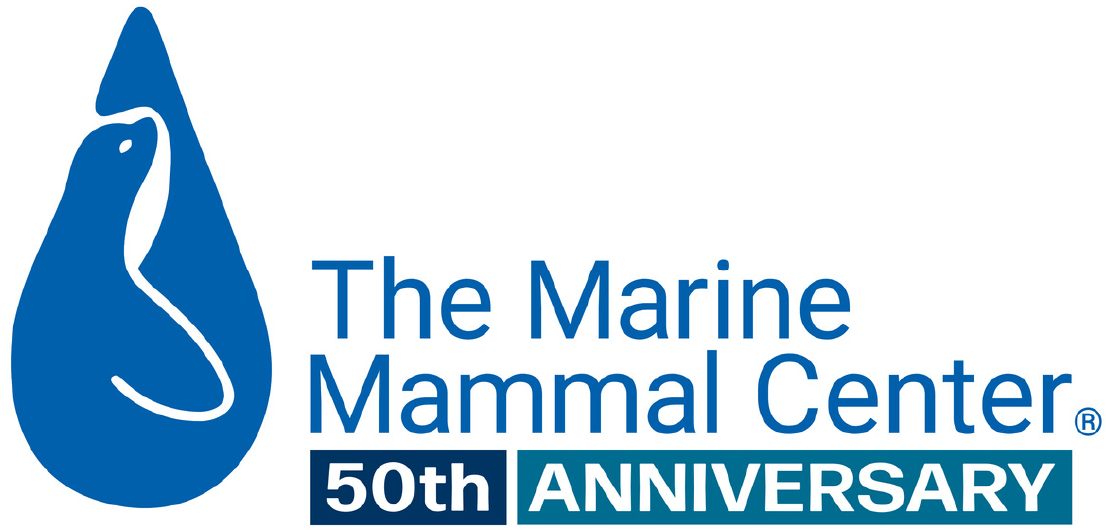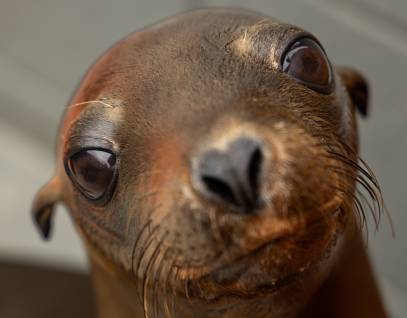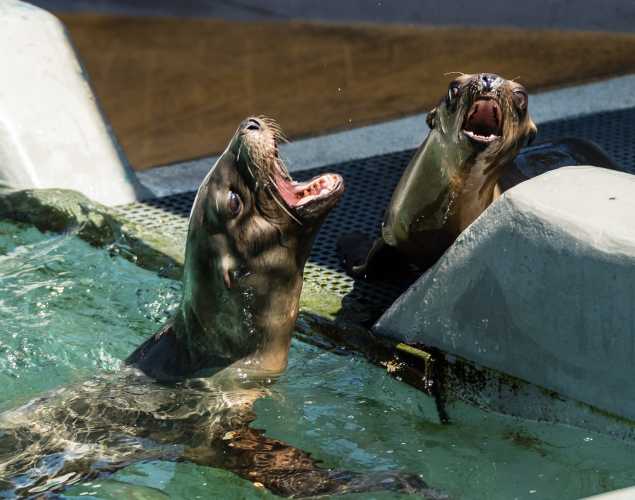
California Sea Lion Crisis Far From Over, Researchers Say
- Malnutrition
- Climate change
Warm waters along the West Coast are affecting food availability for nursing sea lion mothers, and the result is a generation of pups that are smaller than researchers have ever seen. These starving sea lions are washing ashore on California beaches.
Stand quietly for a moment on an observation deck at The Marine Mammal Center, and you’ll likely hear the playful bark of a sea lion coming from one of the more than 170 patients onsite right now. The exact intention—whether “I’m hungry” or “quit bugging me”—may remain a mystery, but it’s clear these sea lions are trying to tell us something.
Their very presence here in such great numbers at this time of year is sounding an alarm up and down the coast, not just because of the resources that must go into caring for this many animals but because it signals something complex happening in our ocean and coastal environment.
“Each animal rescued is a puzzle piece to give us big-picture information on what’s happening in the marine environment and throughout the West Coast,” says Justin Viezbicke, California’s Stranding Network Coordinator for NOAA Fisheries, the federal agency that manages marine mammal stranding response.
Thus far in 2015, more than 1,200 California sea lions have been admitted to rehabilitation facilities across the state, NOAA says. The Marine Mammal Center alone has responded to more than 400 sea lions since the beginning of the year, and we have more sea lions at our hospital than ever before in our 40-year history.
So what are these hundreds of “puzzle pieces” telling us? The big picture is complicated.
California Sea Lions in Crisis
Experts believe what’s happening with the sea lions is related to large swaths of warm water in the Pacific that are affecting distributions of fish. This unusually warm water extends from the Aleutian Islands through Alaska, down the West Coast along the Washington, Oregon and California coasts and out to Hawaii.
Although reminiscent of El Niño conditions, these warm water patches are actually caused by unusually weak winds from the north and strong winds from the south, which result in a change in currents and a lack of upwelling that would typically bring colder water—and an abundance of fish—to the surface, making prey more plentiful and accessible.
Some areas of the Pacific are two to five degrees Fahrenheit warmer than usual for this time of year—some of the warmest temperatures seen in our history, says NOAA Climatologist Nate Mantua.
In fact, just today NOAA officials declared an El Niño event for 2015 based on the continued development of warmer temperatures in the tropical Pacific. This is not good news for sea lions. Mantua says this development “could favor a set of weather patterns and currents that will cause warm water to persist along the coast through summer and possibly the end of the year.”
This unusual weather pattern driven by the winds, which is also related to the severe winter in the Northeast and the extreme drought on the West Coast, is largely considered an anomalous event.
But some scientists suggest climate change may play a role as well—that warming sea-surface temperatures worldwide and reduced sea ice are amplifying this atmospheric abnormality.
Other large-scale impacts humans are having on the ocean environment, such as overfishing and pollution, are certainly not helping the problem either. Recent fisheries assessments reveal, for example, that the sardine population—a major food source for sea lions—has dropped 72 percent since its last peak in 2006.
Regardless of why this major oceanographic change is happening, the ripple effects are being felt acutely along the coast of California as starving sea lion pups continue to wash ashore.
Dive Deeper
{"image":"\/Animals\/Wild\/Other species\/whale-with-oil-rig-shutterstock.jpg","alt":"whale feeding with oil rig in background","label":"Conservation","title":"Climate Change","link_url":"\/science-conservation\/conservation\/climate-change","type":"page"}
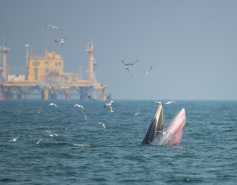
Going Straight to the Source
While each sea lion rehabilitating at The Marine Mammal Center gets individualized care, our experts are also focused on what’s happening with these animals on a larger scale. California sea lions are very sensitive to their environment and can serve as a sentinel species, alerting us to major changes in the ocean based on whether they are struggling or thriving.
That’s why we work closely with researchers like Sharon Melin, of NOAA’s National Marine Mammal Laboratory, who have been monitoring California’s sea lion population for years.
In September 2014, Melin and her team, along with veterinary staff from The Marine Mammal Center, visited the sea lion rookeries on the Channel Islands, a primary breeding area, to assess the pups born three months prior.
The field teams weighed, tagged and took samples from sea lion pups throughout the islands and compared their data with historical records that go back 40 years. They found that nearly 20 percent of the pups were below average weight.
When Melin and her research team returned a few weeks ago to check up on these same pups, they found that the number of pups below average weight had more than doubled.
They calculated the growth rate for these pups over the four-month period and found that it was just two-tenths of a pound per day—or about 3.5 ounces—the lowest they had ever observed since they began recording growth rates in the early 1990s.
In fact, about 40 percent of the pups had either not gained any weight in that four months or had lost weight.
The scene on the Channel Islands this year is grave, worse even than what researchers saw in 2012, before the Unusual Mortality Event in 2013 that resulted in the strandings of about 1,600 sea lions. Melin says she has seen a consistent downward trend for these animals over the last six years.
The Waiting Game
Researchers have also been monitoring sea lion mothers with pups on the Channel Islands. In order to provide sustenance for their pups, sea lion mothers have to leave their pups on the beach while they forage for fish. Typically, they’ll spend two to four days fishing as far north as Monterey Bay and then return to the islands to nurse their pups for a day or two.
By attaching temporary satellite tags to sea lion mothers, researchers were able to capture data on how long the mothers were away from their pups and where they were going to forage for fish.
What they learned is that the sea lion mothers don’t seem to be traveling much further than usual but appear to be having difficulty finding food in their normal feeding area. Researchers say it’s possible that these mothers are having a harder time finding the quantity or type of food they need to sustain themselves and their pups—a finding consistent with the oceanographic changes climatologists are reporting.
Meanwhile, the pups are fasting for up to a week at a time waiting for their mothers to return. If a mother sea lion is gone for too long, the pup can lose energy and the result is a slow growth process and in extreme cases, starvation.
“These pups are not capable of being on their own,” Melin says. “They don’t have the skills to forage.” In general, pups are usually weaned in April and if they are weaned before that, they don’t have a great chance, she adds.
The pups that tire of waiting for their mothers and head out to sea are washing up all along the California coastline. But the low pup growth rates seen throughout the Channel Islands seem to indicate that the chances for the pups that stay with their mothers for another few months aren’t great either.
While experts aren’t worried about the California sea lion population as a whole, they’ve warned rehabilitation centers up and down the coast to brace for a particularly rough year, with sea lion strandings expected to continue for months to come.
No Seal Left Behind
Despite the record number of animals in need of rescue right now, The Marine Mammal Center’s goal is to never turn a patient away. As the largest marine mammal rehabilitation facility in the world, we have the ability to handle a large number of patients at once.
We are responding to every stranded marine mammal reported to our rescue hotline within the 600-mile range of California coastline for which we are the authorized responder. Our stranding experts are assessing every individual and evaluating each case based on the animal’s condition and location.
Any animal brought into our hospital is carefully assessed during an admit exam and put on a treatment plan of regular feedings and medication as needed. A starving sea lion pup arriving today will likely stay at our hospital recovering for the next four to six weeks.
Once these pups are treated for any secondary illnesses they may have and are able to put on a healthy amount of weight, they are returned to the wild. Many of these young sea lions are being released at Point Reyes National Seashore, a location that gives them the best chance at finding suitable food sources.
An Uncertain Future
For now, The Marine Mammal Center is tackling this current crisis one sea lion at a time. “What’s scary is that we don’t know when this will end,” says Dr. Shawn Johnson, Director of Veterinary Science at The Marine Mammal Center. “This could be the new normal—a changed environment that we’re dealing with now.”
Experts are able to explain how all of this is all happening—changing wind patterns lead to a lack of upwelling, which leads to warmer waters, which leads to a redistribution of fish, which causes mother sea lions to take longer foraging trips, which leads to hungry sea lion pups.
But they aren’t necessarily able to explain why. No one predicted these abnormal wind patterns, so no one can predict when they will end and when the ecosystem will right itself.
“We know everything is connected—a change in the winds is leading to thousands of sea lions stranding on the beach,” Johnson says. “It’s all the more reason we should be paying close attention to what the sea lions are trying to tell us.”
Yes, I want to save a life!
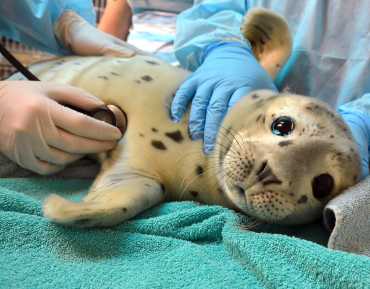
Yes, I want to save a life!
You’ll be giving sick and injured animals the best possible care at the Center’s state-of-the-art hospital. With your gift today, you are giving a patient a second chance at life in the wild.
See Our Latest News
{"image":"\/Animals\/Wild\/California sea lion\/cropped-images\/csl-release-4-5-24photo-by-chris-deimler-c-the-marine-mammal-center-138-0-1270-992-1745348188.jpg","alt":"Four young California sea lions walk on the beach toward the ocean.","title":"Achievements in Ocean Health","link_url":"https:\/\/www.marinemammalcenter.org\/news\/achievements-in-ocean-health","label":"News Update","date":"2025-04-23 10:20:00"}

{"image":"\/Misc\/Graphics\/cropped-images\/climate-change-graphic-giant-earth-shutterstock-1798-6-5113-3994-1680046432.jpg","alt":"An Earth Day graphic of people holding the planet, recycling, planting a tree and moving a solar panel.","title":"5 Ways to Celebrate Earth Day","link_url":"https:\/\/www.marinemammalcenter.org\/news\/5-ways-to-celebrate-earth-day","label":"News Update","date":"2025-04-18 11:21:08"}

{"image":"\/Animals\/Wild\/Sea otter\/cropped-images\/sea-otter-mom-pup-photo-c-brian-simuro-505-0-3387-2646-1618247266.jpg","alt":"sea otter mother and pup","title":"Meaningful Mother\u2019s Day Gifts for Ocean Lovers","link_url":"https:\/\/www.marinemammalcenter.org\/news\/eco-friendly-mothers-day-gifts-that-give-back","label":"News Update","date":"2025-04-10 02:00:00"}

{"image":"\/Animals\/Wild\/Harbor seal\/cropped-images\/harbor-seals-shutterstock-107-0-1270-992-1744225508.jpg","alt":"A group of harbor seal pups and mothers on the beach during pupping season.","title":"Your Guide to Seeing Harbor Seal Pups in California","link_url":"https:\/\/www.marinemammalcenter.org\/news\/your-guide-to-seeing-harbor-seal-pups-in-california","label":"News Update","date":"2025-04-10 00:00:00"}

climate change
California Sea Lion
